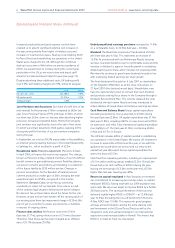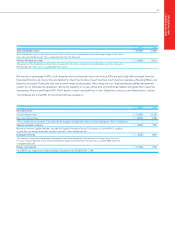Tesco 2007 Annual Report Download - page 18
Download and view the complete annual report
Please find page 18 of the 2007 Tesco annual report below. You can navigate through the pages in the report by either clicking on the pages listed below, or by using the keyword search tool below to find specific information within the annual report.
Operating and financial review continued
16 Tesco PLC Annual report and financial statements 2007 Find out more at www.tesco.com/corporate
Suppliers & Farmers
• We are committed to increasing the number of local
products in store. Regional roadshows in Cornwall, the
Isle of Wight, the North-West and Wales attracted over
300 small suppliers and we have already launched 58
new lines in our South West stores as a result of the
roadshow in Cornwall.
• We will help dairy farmers by offering direct contracts to
named farmers, raising the price they receive to around 22
pence per litre, and sourcing more for our ‘Localchoice’ milk
from local farms – this will be sold for slightly more per litre
than standard milk so that these smaller producers can
make returns more in line with the proportionately higher
costs of their business.
Risks and uncertainties
Introduction Risk is an accepted part of doing business. The
real challenge for any business is to identify the principal risks
and to develop and monitor appropriate controls. A successful
risk management process balances risks and rewards and relies
on a sound judgement of their likelihood and consequence.
The Tesco Board has overall responsibility for risk management
and internal control within the context of achieving the Group’s
objectives. Our process for identifying and managing risks is set
out in more detail on page 24 of the Corporate Governance
Statement in this Annual Report. The key risks and mitigating
factors are set out below.
Business strategy If our strategy follows the wrong direction or
is not efficiently communicated then the business may suffer.
We need to understand and properly manage strategic risk in
order to deliver long-term growth for the benefit of all our
stakeholders. Our strategy is based on a four-part strategy:
to grow the core UK business, be as strong in non-food as
in food, develop retailing services and become a successful
international retailer. Pursuit of this four-part strategy has
allowed the business to diversify. At a strategic level,
diversification and pursuit of growth in emerging markets has
the effect of reducing overall risk by avoiding reliance on a
small number of business areas. However, by its very nature,
diversification also introduces new risks to be managed in
areas of the business that are less mature and fully understood.
To ensure the Group continues to pursue the right strategy,
we dedicate two full days a year to reviewing strategy as well as
discussing it at every Board meeting. The Executive Committee
also holds specific sessions on a regular basis. We have
structured programmes for engaging with all our stakeholders
including customers, employees, investors, suppliers,
government, media and non-governmental organisations.
We also invest significant resources in ensuring our strategy
is communicated well and understood by the parties who are
key to delivering it. The business operates a ‘Steering Wheel’ –
a balanced scorecard process – in all countries and significant
business units such as Dotcom to help manage performance
and deliver business strategy.
Financial strategy and Group Treasury Risk The main
financial risks of the Group relate to the availability of funds to
meet business needs, the risk of default by counter-parties to
financial transactions, and fluctuations in interest and foreign
exchange rates.
The Treasury function is mandated by the Board to manage
the financial risks that arise in relation to underlying business
needs. The function has clear policies and operating
parameters, and its activities are routinely reviewed and
audited. The function does not operate as a profit centre and
the undertaking of speculative transactions is not permitted.
A description of the role of the Finance Committee and
Internal and External Audit is set out in the Corporate
Governance section, page 25 of the Annual Report.
Operational threats and performance risk in the business
There is a risk that our business may not deliver the stated
strategy in full particularly since, like all retailers, the business is
susceptible to economic downturn that could affect consumer
spending. The continuing acquisition and development of
property sites also forms an intrinsic part of our strategy and
this carries inherent risks.
We try to deliver what customers want better than our
competitors by understanding and responding to their
behaviour. All of our business units have stretching targets
based on the Steering Wheel and the performance of all
business units is monitored continually and reported monthly
to the Board. We manage the acquisition and development of
our property assets carefully. We consider and assess in detail
every site at each stage of acquisition and development and
ensure that relevant action is taken to minimise any risks.
Our aim is to have broad appeal to all customers in our
different markets, minimising the impact of changes to the
economic climate.
Competition and consolidation The retail industry is highly
competitive. The Group competes with a wide variety of
retailers of varying sizes and faces increased competition from
UK retailers as well as international operators here and overseas.
























